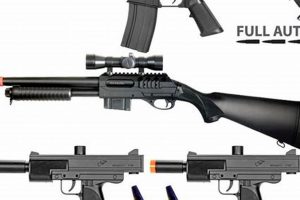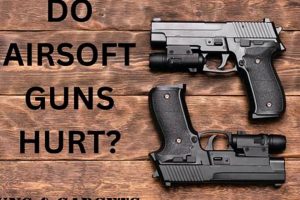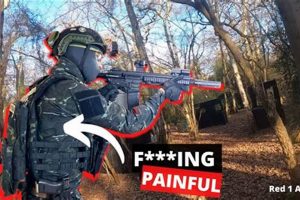The transportation of realistic replica firearms, such as those used in airsoft, aboard commercial aircraft is subject to strict regulations. These regulations are designed to ensure passenger safety and prevent potential security threats. Specific procedures and guidelines exist for both checked and carry-on baggage related to items that resemble actual weapons.
Adherence to established transportation protocols mitigates risks associated with misidentification or misuse of these items. Furthermore, compliance with airline and transportation security administration policies prevents delays, confiscation of property, and potential legal repercussions. The historical context of these regulations stems from heightened security concerns related to air travel following various incidents involving weapons and potential threats.
This document will outline the specific requirements for transporting airsoft guns, including necessary packaging, declaration procedures, and airline-specific rules. It will also address potential consequences of non-compliance and offer resources for verifying current regulations with relevant authorities.
Essential Guidance on Transporting Airsoft Guns
The following recommendations are designed to assist individuals in the safe and lawful transportation of airsoft guns on commercial aircraft. Diligent adherence to these guidelines can prevent potential complications and ensure compliance with applicable regulations.
Tip 1: Declaration is Mandatory: Prior to travel, it is imperative to declare the airsoft gun to the airline representative at the check-in counter. Failure to declare may result in confiscation and potential legal penalties.
Tip 2: Secure Packaging is Required: The airsoft gun must be unloaded and packaged in a hard-sided case. This case should be locked and inaccessible during transit to prevent unauthorized access.
Tip 3: Ammunition Restrictions Apply: Ammunition, including BBs, must be transported separately from the airsoft gun. These items are typically restricted to checked baggage and must be appropriately packaged to prevent accidental discharge or spillage.
Tip 4: Airline-Specific Policies Must be Verified: Each airline may have specific rules and regulations regarding the transportation of replica firearms. Contacting the airline directly prior to travel is crucial to confirm compliance with their individual policies.
Tip 5: TSA Regulations Must Be Adhered To: The Transportation Security Administration (TSA) maintains regulations regarding the transportation of firearms and replica firearms. Familiarity with and adherence to these regulations is essential.
Tip 6: Local Laws Should Be Considered: Destination and layover locations may have specific laws regarding the possession and transportation of airsoft guns. Researching and complying with these local regulations is crucial to avoid legal issues.
Following these recommendations ensures the safe and legal transport of airsoft guns, reducing the risk of delays, confiscations, or legal ramifications.
Further sections will detail the legal implications and provide resources for verifying current regulations.
1. Airline Regulations
Airline regulations constitute a primary determinant in the feasibility of transporting airsoft guns on commercial aircraft. These regulations establish the specific protocols and restrictions governing the acceptance and handling of items resembling firearms, directly impacting whether an airsoft gun can be legally transported.
- Declaration Policies
Airlines mandate the declaration of airsoft guns during the check-in process. This requirement necessitates informing airline personnel of the presence of such items in checked baggage. Failure to declare constitutes a violation of airline policy and may result in penalties, including confiscation or legal action. Declaration allows the airline to ensure proper handling and compliance with security protocols.
- Packaging Requirements
Airlines typically stipulate that airsoft guns be transported in locked, hard-sided cases. This packaging standard aims to prevent accidental discharge or unauthorized access during transit. The rigidity of the case offers protection against damage, while the locking mechanism enhances security. Non-compliance with packaging requirements may lead to rejection of the item at check-in.
- Ammunition Restrictions
Airline regulations often address the transportation of ammunition, including BBs used in airsoft guns. These regulations commonly require that ammunition be transported separately from the airsoft gun, typically in checked baggage, and in secure packaging. Limits on the quantity of ammunition permitted may also apply. Failure to adhere to ammunition restrictions can result in confiscation and potential fines.
- Airline-Specific Variations
It is crucial to recognize that airline regulations concerning airsoft guns can vary significantly between carriers. Some airlines may impose stricter requirements or outright prohibit the transportation of such items. Passengers are responsible for verifying the specific policies of their chosen airline prior to travel. Failure to do so can lead to unexpected complications at the airport.
The interplay of these facets underscores the critical importance of researching and adhering to airline regulations when planning to transport an airsoft gun. Neglecting to comply with these regulations can result in travel disruptions, financial penalties, and potential legal repercussions. Prior communication with the airline is strongly recommended to ensure a seamless travel experience.
2. TSA Guidelines
The Transportation Security Administration (TSA) establishes baseline security protocols for air travel within the United States. These guidelines directly influence the transport of items that resemble firearms, including airsoft guns, and therefore are a critical consideration when determining whether transporting such items is permissible.
- Checked Baggage Requirements
The TSA mandates that airsoft guns must be transported in checked baggage only. These items are prohibited in carry-on luggage. This regulation aims to prevent potential threats within the passenger cabin. The requirement applies to all airsoft guns, regardless of their size, power, or realism. Failure to comply results in confiscation and possible penalties.
- Hard-Sided Case Mandate
To mitigate the risk of damage or misuse, the TSA requires airsoft guns to be securely packed in a hard-sided case. The case must be lockable, and the airsoft gun should be unloaded. This requirement provides a physical barrier against accidental discharge and deters unauthorized access. Soft cases or other inadequate packaging are not permitted.
- Declaration and Inspection
While the TSA does not explicitly require declaration of airsoft guns at the check-in counter, it is strongly recommended. Declaring the item allows airline personnel and TSA agents to conduct necessary inspections efficiently. Failure to declare may raise suspicion and prolong the security screening process. TSA officers retain the right to inspect any checked baggage, including cases containing airsoft guns.
- Federal vs. Local Regulations
TSA guidelines represent federal regulations, but state and local laws may impose additional restrictions on the possession and transportation of airsoft guns. Travelers are responsible for understanding and complying with all applicable laws at both their departure and arrival locations. The TSA does not supersede local laws, and compliance with TSA guidelines does not guarantee compliance with all applicable regulations.
In summary, while TSA guidelines provide a framework for transporting airsoft guns, adherence to these guidelines alone does not guarantee the permissibility of transport. Compliance with airline-specific policies, local laws, and proper declaration procedures remain essential. The interplay of these factors ultimately determines whether an airsoft gun can be transported safely and legally.
3. Declaration Requirement
The declaration requirement constitutes a pivotal component in determining whether an airsoft gun can be transported on a commercial aircraft. Its importance stems from the need to inform both airline personnel and security agencies about the presence of an item that closely resembles a firearm. Failure to declare initiates a cascade of potential negative consequences, directly impacting the feasibility of transport. For instance, consider a scenario where a passenger fails to declare an airsoft gun contained within checked baggage. Upon discovery during security screening, the undeclared item may be subject to confiscation, resulting in significant delays and potential fines. This situation highlights the direct cause-and-effect relationship between non-compliance with the declaration requirement and the inability to transport the airsoft gun.
Furthermore, the act of declaration serves a crucial security function. By informing the airline, the passenger allows for appropriate handling and inspection procedures to be implemented. This includes verifying that the airsoft gun is unloaded, properly packaged in a hard-sided case, and that ammunition is transported separately according to regulations. The declaration process also provides an opportunity for airline personnel to confirm compliance with all applicable rules and regulations, minimizing the risk of unforeseen complications during transit. The declaration process is designed to ensure accountability and transparency, mitigating potential security risks associated with transporting realistic replica firearms.
In summary, the declaration requirement is not merely a procedural formality; it is an integral element in the process of legally and safely transporting airsoft guns on aircraft. Its significance lies in its ability to facilitate proper security screening, ensure compliance with regulations, and prevent potential misunderstandings or security breaches. Ignoring this requirement jeopardizes the entire transport process and may lead to substantial penalties and delays.
4. Packaging Standards
Stringent packaging standards are directly linked to the permissibility of transporting airsoft guns on commercial aircraft. These standards are not arbitrary; they are meticulously designed to mitigate risks, ensure safety, and comply with both airline and regulatory body requirements. Failure to adhere to these standards can result in immediate denial of transport.
- Hard-Sided Case Requirement
The requirement for a hard-sided case serves as a primary safeguard against accidental damage or discharge during transit. This case must be robust enough to withstand the rigors of baggage handling and prevent external pressure from activating the airsoft gun. For example, a flimsy cardboard box would be deemed unacceptable, while a lockable, reinforced plastic case would typically meet the standard. This regulation directly affects whether an airsoft gun is accepted, as it addresses the fundamental concern of unintentional activation or damage.
- Locking Mechanism Necessity
The inclusion of a functional locking mechanism on the hard-sided case is not merely a suggestion but a mandatory requirement. This lock prevents unauthorized access to the airsoft gun, thereby reducing the potential for theft or misuse. Airlines and security personnel require assurance that the item is secure and cannot be accessed without proper authorization. A missing or non-functional lock immediately jeopardizes the transport of the airsoft gun, as it undermines the intended security measures.
- Unloaded Condition Verification
Although seemingly implicit, packaging standards indirectly emphasize the necessity of transporting the airsoft gun in an unloaded condition. While not a physical aspect of the packaging itself, the expectation is that the gun is rendered inoperable during transit. Security personnel may inspect the packaging to verify the absence of ammunition or any other components that could lead to accidental discharge. Failure to ensure the airsoft gun is unloaded can lead to severe consequences, including legal penalties, and will undoubtedly prevent its transport.
- Concealment Prohibition
Packaging standards implicitly prohibit any attempt to conceal the airsoft gun within other items or disguise its true nature. The item must be readily identifiable and accessible for inspection by security personnel. Attempting to hide the airsoft gun within clothing or other personal belongings constitutes a violation of regulations and will result in denial of transport and potential legal ramifications. Transparency and straightforward presentation of the item are paramount.
The convergence of these packaging-related facets underscores their collective impact on the feasibility of transporting airsoft guns by air. Adherence to these standards is not optional; it is a prerequisite for compliance with airline regulations and security protocols. Neglecting any aspect of these packaging requirements directly jeopardizes the ability to transport the airsoft gun and may lead to severe consequences.
5. Local Laws
Local laws significantly influence the permissibility of transporting airsoft guns, adding a layer of complexity beyond federal and airline regulations. These laws govern possession, transportation, and use of airsoft guns within specific jurisdictions, directly affecting whether an individual can legally bring such items into or through those areas. Disregarding local ordinances can lead to legal consequences, regardless of compliance with federal or airline policies.
- Possession Restrictions
Many localities impose restrictions on the possession of airsoft guns, particularly by minors. Some jurisdictions require individuals to be a certain age to own or possess an airsoft gun, regardless of whether it is being transported or used. For example, a city ordinance might prohibit anyone under the age of 18 from possessing an airsoft gun without adult supervision. Violation of these possession restrictions can result in fines, confiscation of the airsoft gun, or even criminal charges, irrespective of whether the individual intends to transport it on an aircraft.
- Transportation Regulations
Local laws often dictate how airsoft guns must be transported within the jurisdiction. These regulations might require that the airsoft gun be stored in a locked container, out of plain sight, and unloaded during transport. Some cities or states may prohibit the open carry of airsoft guns altogether, even if they are unloaded and in a case. For instance, a county ordinance might mandate that airsoft guns be transported in the trunk of a vehicle, separate from any ammunition. Failure to comply with these transportation regulations can result in legal penalties, potentially jeopardizing the individual’s ability to continue their journey by air.
- Use Restrictions
Local laws frequently regulate the use of airsoft guns, restricting their discharge to designated areas such as private property or licensed airsoft fields. Discharging an airsoft gun in public places, residential areas, or within city limits may be prohibited, even if the individual possesses the airsoft gun legally. For example, a city ordinance might forbid the discharge of airsoft guns within 500 feet of a school or park. While use restrictions do not directly pertain to air travel, they can impact an individual’s justification for transporting the airsoft gun, potentially raising suspicion during security screening if the intended use violates local laws.
- State Preemption
It is important to note that state laws can sometimes preempt local ordinances, meaning that state regulations override conflicting local rules. However, the absence of state preemption means local laws remain in effect. An individual must ensure that the state law doesn’t invalidate local restrictions or impose different regulations. Researching both state and local statutes is thus crucial.
In conclusion, local laws represent a critical factor in determining whether an airsoft gun can be transported to a specific destination. These laws govern possession, transportation, and use of airsoft guns, adding a layer of complexity beyond federal regulations and airline policies. Travelers must research and comply with all applicable local laws at both their departure and arrival locations to avoid potential legal consequences and ensure the permissibility of transporting their airsoft gun.
6. Ammunition Rules
Ammunition regulations play a critical, definitive role in determining the feasibility of transporting airsoft guns on commercial aircraft. These rules govern the permissible carriage of projectiles used in airsoft devices, and any non-compliance directly affects the ability to transport the associated airsoft gun.
- Type Restrictions
Airlines and regulatory bodies, such as the TSA, often specify acceptable ammunition types. Certain materials or projectile compositions might be prohibited due to safety or security concerns. For instance, metallic projectiles could be banned, while biodegradable plastic BBs might be permissible under specific conditions. Deviation from these approved types directly impedes the airsoft gun’s transport.
- Packaging Requirements
Regulations mandate that ammunition must be securely packaged to prevent spillage or accidental discharge. Typically, this involves storing BBs in a sealed container or the original manufacturer’s packaging. Loose ammunition scattered within luggage is strictly prohibited, posing a safety risk and violating transportation policies. The manner of packaging directly influences acceptance for travel.
- Quantity Limitations
Airlines commonly impose quantity restrictions on the amount of ammunition that can be transported, even when permitted. These limits are designed to minimize potential risks associated with large quantities of projectiles. Exceeding the allowable amount, measured by weight or volume, can result in confiscation of the excess ammunition or denial of transport for the airsoft gun itself.
- Separation Mandate
Ammunition must be transported separately from the airsoft gun. This often means storing the BBs in a different compartment of checked baggage than the airsoft gun case. This separation aims to prevent accidental loading or unintentional use of the device during transit. Failure to comply with this separation requirement can lead to rejection of both the airsoft gun and its ammunition.
These facets of ammunition regulations highlight their significant connection to the question of whether airsoft guns can be taken on a plane. Compliance with these rules is essential; non-compliance directly threatens the ability to transport both the airsoft gun and its associated ammunition, irrespective of adherence to other regulations. Understanding and strictly adhering to these ammunition-specific rules is thus a critical prerequisite for successful air travel with airsoft equipment.
Frequently Asked Questions
The following section addresses common inquiries regarding the transportation of airsoft guns on commercial aircraft. The information provided aims to clarify relevant regulations and procedures.
Question 1: Is it permissible to transport an airsoft gun in carry-on baggage?
No, airsoft guns are strictly prohibited in carry-on baggage. These items must be transported in checked baggage only, in accordance with TSA guidelines and airline regulations.
Question 2: What type of case is required for transporting an airsoft gun?
Airsoft guns must be transported in a hard-sided case that is lockable. Soft cases or other inadequate packaging are not acceptable.
Question 3: Is it necessary to declare an airsoft gun at the check-in counter?
While not always explicitly required by the TSA, declaring the airsoft gun at the check-in counter is strongly recommended. This allows airline personnel to ensure proper handling and compliance with security protocols.
Question 4: Can ammunition for an airsoft gun be transported in the same case as the gun itself?
No, ammunition must be transported separately from the airsoft gun. It should be packaged securely in a separate container and transported in checked baggage.
Question 5: Are there any restrictions on the type or quantity of ammunition that can be transported?
Airlines may impose restrictions on the type and quantity of ammunition that can be transported. It is essential to verify these restrictions with the specific airline prior to travel.
Question 6: Do local laws at my destination affect the transport of my airsoft gun?
Yes, local laws at both your departure and arrival locations can significantly impact the permissibility of transporting an airsoft gun. It is crucial to research and comply with all applicable local laws.
In summary, transporting airsoft guns by air requires meticulous adherence to federal, state, and local regulations, as well as airline-specific policies. Failure to comply can result in confiscation, fines, or legal penalties.
The next section will provide resources for verifying current regulations and obtaining further information.
The preceding discussion has elucidated the complexities surrounding the question: can you take airsoft guns on a plane? The determination hinges on a confluence of factors including strict adherence to airline policies, TSA guidelines, local laws governing possession and transport, declaration protocols, ammunition regulations, and secure packaging standards. Non-compliance with any of these elements can lead to confiscation of property, imposition of fines, or potential legal repercussions.
The onus rests upon the traveler to thoroughly investigate and comply with all relevant regulations prior to attempting to transport an airsoft gun on a commercial aircraft. Given the potential ramifications of non-compliance, proactive due diligence and direct verification with airlines and relevant authorities are strongly advised to ensure a seamless and lawful travel experience. Failure to do so carries significant risk.




![Enhance Game: Best Airsoft Heavy Machine Gun Guide [Year] Ultimate Airsoft Guide for Beginners, Tactics & Gear Reviews Enhance Game: Best Airsoft Heavy Machine Gun Guide [Year] | Ultimate Airsoft Guide for Beginners, Tactics & Gear Reviews](https://airsoftica.com/wp-content/uploads/2025/11/th-928-300x200.jpg)


